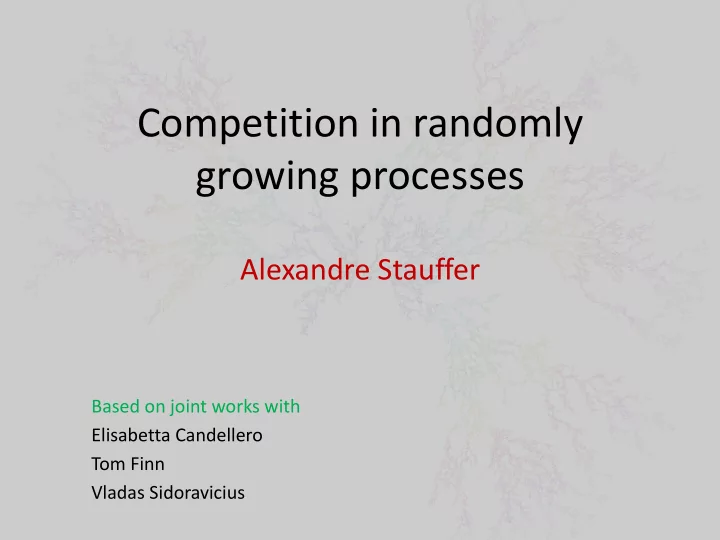

Competition in randomly growing processes Alexandre Stauffer Based on joint works with Elisabetta Candellero Tom Finn Vladas Sidoravicius
First Passage Percolation (FPP) ❖ Start from the origin of ℤ 𝑒 ❖ Grow by adding boundary edge at rate 1 ➢ A boundary edge is added u.a.r. ➢ Defines a random metric: each edge has random weight ∼ Exp(1) First passage percolation (FPP): ▪ Eden (1961) to model problems in cell reproduction ▪ Hammersley and Welsh (1965) for general graphs and general passage Shape theorem: forms a ball times
FPP Competition Two-type Richardson Model Start from neighboring vertices ❖ Type 1 performs FPP at rate 1 ❖ Type 2 performs FPP at rate 𝜇 Each vertex gets occupied by the type that arrives to it first Main questions 1. Which type produces an infinite cluster? (survival) 2. Is there coexistence? (i.e., both types produce infinite clusters)
Two-type Richardson Model Theorem 1 [coexistence] ℙ coexistence > 0 if 𝜇 = 1 O. Haggstrom and R. Pemantle. First passage percolation and a model for competing spatial growth. Journal of Applied Probability , 1998 C. Hoffman. Coexistence for Richardson type competing spatial growth models. Annals of Applied Probability , 2005 O. Garet and R. Marchand. Coexistence in two-type first-passage percolation models. Annals of Applied Probability , 2005 Conjecture ℙ coexistence > 0 iff 𝜇 = 1 Theorem 2 [no coexistence] ℙ coexistence = 0 for all but countably many values of 𝜇 O. Haggstrom and R. Pemantle. Absence of mutual unbounded growth for almost all parameter values in the two-type Richardson model. Stochastic Processes and their applications , 2000
FPP in hostile environment Type 1 starts from the origin ❖ Perform FPP at rate 1 Type 2 starts from seeds of IID Bern( p ), which ❖ Do not evolve from time 0 ❖ get activated when type 1 tries to occupy it ❖ After activation, evolve as FPP at rate 𝜇 Main questions ▪ Which type produces an infinite cluster? (Type 2 is always an infinite set) ▪ Is there coexistence? site (i.e., 1 − 𝑞 > 𝑞 𝑑 site ) Focus on case 𝑞 < 1 − 𝑞 𝑑 No monotonicity! so ℤ 𝑒 ∖ {seeds} has an infinite cluster Adding Type 2 seeds may speed up Type 1 .
Motivation Study of dendritic formation • Invented as a tool to analyze a model from dendritic growth Bacteria under starvation Crystal dendrite Dielectric breakdown Spread of fake news • Type 1 represents spread of fake news • Type 2 spreads the correct information
First Result Theorem [Survival of type 1 for small 𝑞 ] 𝜇 = rate of type 2 𝑞 = density of type 2 seeds For any 𝜇 < 1 , there exists 𝑞 0 ∈ (0,1) such that ∀𝑞 < 𝑞 0 1. ℙ 𝐔𝐳𝐪𝐟 𝟐 survives > 0 2. ℙ ∀𝑢 ≥ 0, Type1 𝑢 ⊃ Ball(𝑑𝑢) > 0 , where Type1 𝑢 = Type1 𝑢 ∪ "finite components of Type1 𝑑 " V. Sidoravicius and A. S. Multi-particle diffusion limited aggregation. Inventiones Mathematicae , to appear Expected behavior: 𝜇 1 ??? Sidoravicius, S. site 1 − 𝑞 𝑑 𝑞
Encapsulation in two-type FPP Two type encapsulation (Haggstrom-Pemantle) Type 2 , slower Type 1 , faster ℙ 𝐔𝐳𝐪𝐟 𝟐 surrounds 𝐔𝐳𝐪𝐟 𝟑 → 1 𝑏𝑡 dist(𝐮𝐳𝐪𝐟 𝟐, 𝐮𝐳𝐪𝐟 𝟑) → ∞
Multi-scale encapsulation
Multi-scale encapsulation
Multi-scale encapsulation
Multi-scale encapsulation
Second result 𝑒 = 2 𝑒 ≥ 3 𝜇 𝜇 1 1 ??? Sidoravicius, S. ??? site site site 𝑞 1 − 𝑞 𝑑 𝑞 𝑑 1 − 𝑞 𝑑 𝑞 Theorem [Survival of type 1 for small λ ] site ) , there exists 𝜇 0 > 0 such that ∀𝜇 < 𝜇 0 For any 𝑞 ∈ (0,1 − 𝑞 𝑑 ℙ 𝐔𝐳𝐪𝐟 𝟐 survives > 0 T. Finn and A.S., Coexistence in competing first passage percolation in 𝑒 ≥ 3 , in preparation site ≠ ∅ site , 1 − 𝑞 𝑑 For 𝑒 ≥ 3 we have 𝑞 𝑑
Hyperbolic (and nonamenable) graphs “fat” triangles 𝑦 𝑦 on ℤ 𝑒 Hyperbolic graphs • All triangles are 𝜀 -thin vs 𝑨 𝑧 𝑧 𝑨 Theorem [Type 2 survives] For any 𝜇 > 0 , any 𝑞 > 0 𝜇 𝜇 ℙ 𝐔𝐳𝐪𝐟 𝟑 survives = 1 1 1 E. Candellero and A.S. Coexistence of competing first passage percolation on hyperbolic graphs, submitted ??? Theorem [Coexistence] site site 𝑞 = 1 − 𝑞 𝑑 𝑞 = 1 − 𝑞 𝑑 For any 𝜇 > 0 , there is 𝑞 0 > 0 s.t. ∀𝑞 < 𝑞 0 ℙ 𝐔𝐳𝐪𝐟 𝟐 survives > 0
Coexistence: overall picture Coexistence is known to hold in the following cases: ❖ Hyperbolic, non-amenable graphs (Candellero, S.) Type 2 always survive ❖ ℤ 𝑒 , 𝑒 ≥ 3 (Finn, S.) Type 2 always survive ❖ ℤ 𝑒 , 𝑒 ≥ 2 for deterministic passage times (Sidoravicius, S.) Type 1 survive with same speed for all 𝜇 < 1 There is no proof of coexistence when both types have to «fight» to survive
Recommend
More recommend